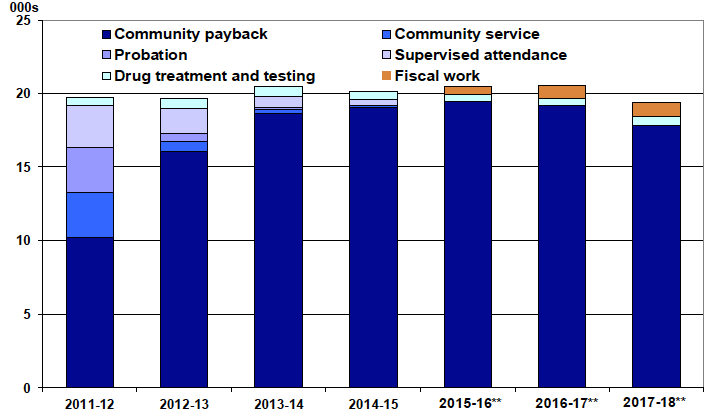Criminal justice social work statistics: 2017-2018
2017-2018 statistics on various areas of criminal justice social work in Scotland.
1 Introduction
1.1 This publication presents national-level information on criminal justice social work activity in Scotland. The report includes data on criminal justice social work services and social work orders, as well as characteristics of the individuals involved.
1.2 The number of social work orders issued has generally been around the 20,000 mark over the last seven years. The most recent figures show 19,400 orders issued in 2017-18, the lowest level over this period (Chart 1 and Table 2).
Chart 1: Social work orders issued: 2011-12 to 2017-18

** Figures for 2015-16, 2016-17 and 2017-18 exclude, respectively, around 200, 150 and 50 legacy orders as details of these were not collected from local authorities in those years (see Annex A).
Highlights
- The number of criminal justice social work reports (including supplementary reports) fell by six per cent to 28,400 in 2017-18. Numbers have dropped by over a fifth since 2011-12, broadly reflecting changes in court volumes (Table 1).
- The number of social work orders issued was 19,400 in 2017-18, a fall of six per cent from 20,600 in 2016-17 and the lowest in any of the last seven years (Table 2).
- There were 17,800 community payback orders commenced in 2017-18, a fall of seven per cent from 19,200 in 2016-17, reflecting the change in court volumes over the period (Table 2).
- Most community payback orders in 2017-18 included a requirement for unpaid work or other activity (75 per cent) and offender supervision (57 per cent) (Table 12). Thirty-one per cent had both of these requirements.
- The prevalence of unpaid work or other activity requirements has been falling in recent years while the prevalence of offender supervision has been increasing (Table 12 and Chart 4).
- People who received a community payback order in 2017-18 were, on average, 2½ years older than those who received one in 2012-13 (Chart 6).
- The successful completion rate for community payback orders was 70 per cent in 2017-18 (Table 2). This has been around the same level in the last seven years. Almost ¾ of community payback orders which terminated in 2017-18 were not subject to any breach applications (Table 21).
- The completion rate for community payback orders was 79 per cent for those aged over 40, compared with 67 per cent for those aged 40 or under. Rates were also higher for the employed/self-employed (84 per cent) than for the unemployed/economically inactive (64 per cent) (Chart 7).
- There were 570 drug treatment and testing orders commenced in 2017-18, the highest level since 2013-14 (Table 2). People aged 31 to 40 have been the most likely per head of population to get a drug treatment and testing order in each of the last five years.
- The successful completion rate for drug treatment and testing orders was 40 per cent in 2017-18, the lowest in the last seven years, with around the same proportion revoked due to review (Table 28). Around ⅔ of drug treatment and testing orders terminated in 2017-18 were not subject to breach applications (Table 30).
There is a problem
Thanks for your feedback